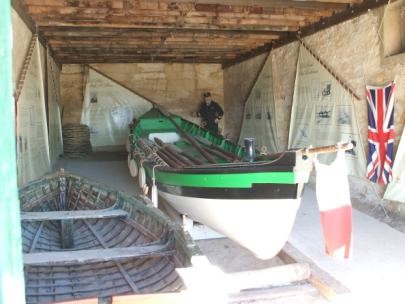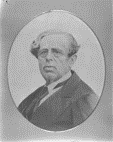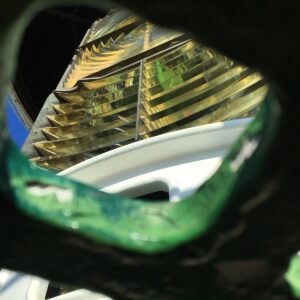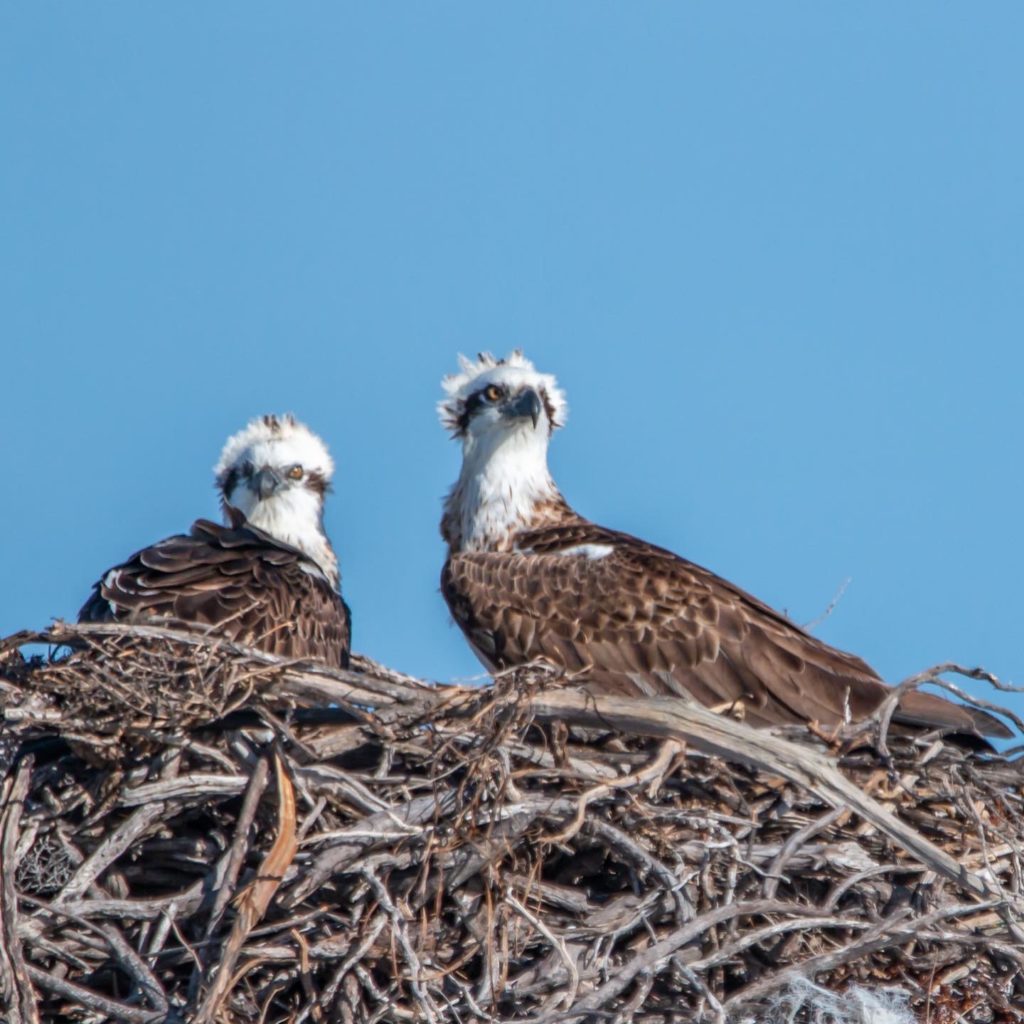Captain Back and his Pilot Crew – Saving lives
Written by Rottnest Voluntary Guide – Daniela, July 2024
In the early days before GPS and mobile phones, the Pilot Boat Captain and crew had an important role to guide ships safely into Fremantle harbour. The pilot boat consisted of a heavy wooden boat with oars with around 6 young men. This boat can be seen at the Pilot Boatshed on the island.

Captain Edward Back was stationed on Rottnest Island in the 1840’s with his family and crew.

The pilot crew would be on call ready to row out anytime day or night in all weather conditions. They rowed to a meeting point 8km off Bathurst point, transferred the pilot by wrapping a rope around his waist, he would climb up onto the ship and navigate it to Fremantle. The crew had to travel to Fremantle and then row back to Rottnest the next day. The life of the pilot crew was dangerous and exhausting.
At least 12 vessels have come aground along the coast and reefs of Rottnest. More information available from the brochure The Rottnest Wrecks Heritage Trail .
Some of the more visible shipwrecks close to the shore include ‘The Shark’ off the beach in shallow waters near Henrietta Rocks and ‘Uribes’ off the coast of Thompson Bay near Phillip Point.
“The Shark” is the most accessible shipwreck only 50 meters from the shore off Henrietta Rocks in shallow waters making it a favourite family swimming spot. ‘The Shark’ broke free from the mooring in Fremantle in the late 1930’s with her barge hitting Henrietta Rocks and sinking.
The ‘Uribes wreck is one of the more recent sunken military sea-farers. In the early 1940, the vessel wrecked just meters from the Natural Jetty in Thompson Bay, after its engines failed and got wedged between the reef and the jetty. It is one of the most well-preserved wrecks with machinery and parts of the hull still in good condition. However, due to strong swells in this area swimmers need to be careful and to check weather conditions before setting off.
The Rottnest Volunteer Guides provide a 30-40 min walking tour ‘Reef Wrecks and daring sailors’ along Thomson Bay waterfront including a stop at the Pilot Boathouse. Join us when next on Rottnest Island!
Beautiful Beaches and Bays on Wadjemup/Rottnest Island
Written by Rottnest Voluntary Guide – Daniela, March 2024
Come enjoy Rottnest’s beautiful bays. Why not explore it by bicycle? You can cycle around in as little as 3hrs or up-to 5 hours (22-25 km) depending upon your cycling abilities, or stops made along the way. There are so many beautiful bays to swim in or just admire the stunning views.

Pushbikes or electric bicycles, and snorkelling gear, can be hired through ferry operators or on the island at “Pedal and Flipper”.
If cycling is not your thing, buy a Bus ticket for either the day or few days to better suit your time on the island.
Come join the many Rottnest Voluntary Guides (in bright yellow shirts) for free, informative talk and walk from Parker Point to Little Salmon Bay. Guides are located around the island sharing many interesting stories and facts.

Why not snorkel our many bays? Be sure to pick up a map of the island at the Visitors Centre or the Rottnest Volunteers information Booth next door to Island Gypsy Rottnest.
There’s a snorkel trail at Little Salmon Bay, only 5km out from the settlement (20 min cycle or less by Bus). The markers and plagues on the sea floor have information on marine life. Look out for tropical fish, pink coral, stingrays, and, dolphins.
There are many marine sanctuaries and the snorkel trail is one of 5 sanctuaries located around the island, protecting fauna and flora. So be sure to leave it as you found it.

The island is unique as it has the warm Leeuwin Current, flowing down from Indonesia. This stimulates the growth of coral around the reefs and attracts tropical marine life. The current increases the water temperature by four degrees to that of the mainland, making underwater experiences more pleasurable.
Before the rise in sea levels, the island was attached to the mainland. These changes have created intriguing caves and thriving habitats for algae, seagrass, tropical coral species and marine life. Look out for Western Rock Lobster in underwater rock caves or octopus.
Bring your surfboards! Surfers enjoy the island’s multiple swell directions and strong conditions with breaks that rival those found down south of Western Australia. Surfers often find a spot with clean offshore winds, making Rottnest a rare and reliable surfing destination.
Due to the extensive reefs and the limited navigational aids in the early days, there are several stories of shipwrecks.
The Rottnest Voluntary Guides, provide 30-40 min free walking tours on various topics. Join us and hear the stories of the ‘Reef Wrecks and Daring Sailors’ and notable captains and sailors.

_______________________________________________________________________________________________________________
Blown away by the view!
Enjoy 360-degree panoramic views of Rottnest Island!
Written by Rottnest Voluntary Guide, Jean Hudson, January 2023
Wadjemup Lighthouse on Rottnest Island is a welcoming sight to mariners approaching the City of Perth and the Port of Fremantle. Perth is the most isolated city in the world, so this light is often the first sign of land after a long sea voyage. The light can be seen for over 50 km.
The first stone lighthouse tower built in Western Australia was completed in 1851 and stood 20-metres high in the centre of Rottnest Island. Despite the construction of this lighthouse, seven ships were wrecked on reefs around the island between 1879 and 1891.

Improvements to the lighthouse proved to be unsuccessful so the decision was made to build a new lighthouse, twice as high and with a more powerful lamp. The old lighthouse continued to function as the new lighthouse was built alongside it.
William Douglass, a British engineer designed the new Wadjemup lighthouse, and Charles Yelverton O’Connor oversaw its construction. The lighthouse was completed in one year at a cost of 3,237 pounds. The new lighthouse was built with limestone cut from the quarry in Nancy Cove. Sir John Forrest, the Premier of Western Australia, laid the foundation stone and the Governor, His Excellency Sir Gerard Smith, opened Wadjemup Lighthouse in 1896.
Wadjemup Lighthouse was the first lighthouse in Australia fitted with a rotating lantern apparatus, which was manufactured in England by Chance Brothers. In 1929, a new mercury float type of pedestal and clockwork revolving mechanism were fitted. The light was electrified in 1936 and became fully automated in 1990. This resulted in the end of an era of lighthouse-keepers on the island.

After almost two years of major restoration and conservation work, this heritage lighthouse has been fully restored and reopened to the public. Tours of the lighthouse are available including a climb to the lantern room and access to the balcony (weather permitting).
Rottnest Voluntary Guides are stationed at Wadjemup Lighthouse to answer your questions and take you on a guided tour. At the upper levels you can see the mercury bath and Fresnel lenses.
The outside viewing platform is 84m above sea level. The upper levels are reached via an internal circular staircase, with stops at each platform to catch your breath and admire different island vistas from the lighthouse windows.
There are 360-degree breathtaking views of Rottnest Island from the viewing platform – the distant Darling Ranges, Indian Ocean, Fremantle Port and Perth City. There are also excellent views of the World War 11 Rottnest Island Fortress: the Oliver Hill Guns, Signal Ridge, Battery Observation Post and Signal Station.

If you choose not to climb the 155 steps to the top, you can explore the site, enjoy the views, and learn more about the building of the lighthouses, the lives of the lighthouse-keepers and its ghosts.
How do you get to Wadjemup Lighthouse? You can cycle there on your own bike or rent a bike from Pedal & Flipperor you can catch the Hop-on Hop-off Bus.
Next time you’re on Rottnest Island, make sure you take the journey to the heritage listed Wadjemup Lighthouse.
Get your heart pumping for views you will not forget!
_____________________________________________________________________________________________________________
Wadjemup Wandering – Part 2
Written by Rottnest Voluntary Guide, Jean Hudson
No doubt you enjoyed a break from hiking and watched the sunset at Pinky’s Beach it is time to continue with the Ngank Yira Bidi and Gabbi Karniny Bidi walking trails on Rottnest Island.
Wardan Nara Bidi. Allow3-4 hours
This is a 10km one-way trail. It begins at Parker Point with its crystal clear water a Rottnest Voluntary Guide will be available to take you on a tour before you start hiking. The Wardan Nara Bidi trail takes you along the coast to Little Salmon Bay, popular for families and snorkelling. Just before Salmon Bay, you’ll discover the 70-year Osprey stack.

Stroll along sandy Salmon Bay and then head inland to Oliver Hill and Wadjemup Lighthouse, the highest point of the island. Take in 360-degree views. The trail then heads to Strickland Bay, Rottnest’s most famous surf break. This trail ends at the Mammong Dreaming Sculpture.
Karlinyah Bidi. Allow2-3 hours
If you enjoyed the island’s northern beaches then this is the trail for you! This one-way 5.9km trail will take you to long sandy deserted beaches with lots of birds and shallow water for swimming – Little Armstrong Bay, perfect for snorkelling. At Catherine Bay keep an eye out for Pied Oystercatchers at the water’s edge.
Along a rocky beach trail, you will arrive at the site where the City of York ship ran aground on the reef. Then onto Ricey Beach (be careful it is very rugged) you’ll find lots of flotsam and jetsam on this beach. Stark Bay is spectacular and a popular haunt for several species of Terns. This trail finishes at Rocky Bay at Narrow Neck.
Ngank Wen Bidi. Allow3-4 hours

This 7.6km trail loops around the rugged and remote West End and begins at narrow neck. Walking anti-clockwise you’ll pass Marjorie Bay, there is a perfect lagoon inside the reef for a dip. Have a look for the crocodile in the rocks at Mabel Bay. Beyond Eagle Bay you’ll arrive at Cathedral Rocks and the viewing platform to watch Long-nosed Fur Seals frolicking in the sea.
Walking along the boardwalk to Cape Vlamingh you will discover incredible views and crashing waves, a blowhole, Osprey’s nest, possibly migrating whales and playful dolphins. The trail loops back to Narrow Neck via the southern coast of the island. Along the way, you will come across popular surfing spots and several Osprey nests. Further information on Rottnest Island can be found at Rottnest Island.
I hope you have enjoyed reading my blog Wadjemup Wandering, better still, why not enjoy the experience of hiking the Wadjemup Bidi Trails.
__________________________________________________________________________________________________________
Written by Rottnest Voluntary Guide, Jean Hudson
Spring is the prefect time to hike the Wadjemup Bidi trails on Rottnest Island. The weather is sunny and not too hot and wildflowers are blooming. Quokka joeys are leaving their mother’s pouch, ducklings and osprey chicks stick close to their parents.
In Noongar language, ‘Wadjemup’ means ‘place across the water where the spirits are’ and ‘Bidi’ means ‘trail’ or ‘track’. The Wadjemup Bidi is a 45-kilometre trail network free of bikes and buses. There are five unique trails that traverse coastal headlands, inland salt lakes, ancient forests of fossilised trees and heritage sites.

Each trail can be hiked separately and spaced out over your time on the island. Trails are linked and they finish and commence near stops for the Hop-on Hop-off Bus. Maps are available from the Rottnest Island Visitors Centre or from the Rottnest Island Volunteer Guides Information Centre. Maps have numbered places of interest, distances and bus stop information.
The five trail sections are: Ngank Yira Bidi – will take you from the settlement to the Bickley Battery. Gabbi Karniny Bidi – features the salt lakes and boardwalk. Wardan Nara Bidi – takes you to Salmon Bay, Oliver Hill and Wadjemup Lighthouse. Karlinyah Bidi the sandy northern beaches and reefs. Ngank Wen Bidi loops around the West End.

Ngank Yira Bidi: Allow 3-4 hours.
Begin this 9.4km one-way trail at Thomson Bay and follow the blue osprey signs. The first section is along the beach towards Kingstown Barracks. Then onto the Bickley Battery, to explore the remnants of the coastal defence system installed before WW2. Two 6-inch guns protected the southern passage to Fremantle from enemy ships.
You’ll find abandoned fortress buildings: plotting rooms, command centres, observation posts, railway sidings and the bases from the two 6-inch guns. These guns had a range of 17 kilometres.
The Jubilee Observation Post is the highest point of Bickley Bay. You can enjoy 360degree views of the island and surrounding waters and marvel at the complex military installations.
The trail takes you past the ‘Osprey Beachcomber’, a sculpture made from 80% recycled material, the onto a rugged dune system to arrive at Henrietta Rocks.
At the lookout of Henrietta Rocks you can see the Shark shipwreck just a short distance offshore. She is one of the many ships that came to grief on the reefs around Rottnest Island. You can end the trail here by catching the hop on hop off bus or finish the trail by walking inland to Oliver Hill.
Oliver Hill Battery has tunnel structures supporting two 9.2-inch guns and railway lines used during WW2. There are incredible views over the Rottnest Island Settlement. You can take a guided tour (offered by the Rottnest Voluntary Guides) of the battery and tunnels, catch the bus back to the settlement or join another trail.
Gabbi Karniny Bidi. Allow 3-4 hours
This 9.7km loop trail takes you around the lakes. It starts from Thomson Bay via the Vlamingh Lookout, which provides amazing views beyond the settlement. Stop at Lake Baghdad and enjoy watching the bird life. Lakes Boardwalk will make you feel as though you are walking on water. The salt lakes occupy 10% of the island’s mass.
The second part of this trail takes you by the turquoise waters of Little Parakeet Bay, stop and have a paddle. At Geordie Bay, you take a break at the café and catch the shuttle bus back to the settlement. Or continue on to Longreach Bay and the Basin. Remember to pack a towel and snorkel … just in case, or maybe end up at Pinky’s Beach for the sunset.
To be continued …..
________________________________________________________________________________________________________________
Fins, Feathers & Flippers
Wildlife watching at Rottnest’s West End turns each visit into an adventure.
Written by Rottnest Voluntary Guide, Jean Hudson

It’s windy and huge waves roll in crashing onto the limestone cliffs sending plumes of spray into the air. The blowhole fills with surf and spray. The water is alive with every colour of blue – cyan, sapphire, aquamarine and turquoise. A pod of bottle nosed dolphins frolic in the waves, some jumping out of the water.
I’m standing on the West End Boardwalk at Cape Vlamingh – the most westerly point of Rottnest Island
A wedge-tailed shearwater glides above me, its flight an elegant pas seul. Shearwaters, also known as mutton-birds are rather clumsy on the ground. They colonise in ground nests and burrows. You’ll see lots of burrows at either side of the boardwalk.
An osprey sits on its nest at the far side of Fish Hook Bay. There are up to 14 osprey nests on the island. Their nests or eyries are large compact structures built from sticks and other debris. These magnificent birds have a wingspan of 1.8m and catch their prey in their claw-like talons. They can dive to a depth of 1m. Ospreys lay 2 -3 eggs from August to October and the fledging remains in the nest until Christmas.
The viewing platform at Cathedral Rocks is the perfect place to watch the antics of the long nosed fur seals. A colony has made Cathedral Rocks home. They sunbathe and roll about on the rocks and do belly flops into the water. They spend half their time in the water – fishing, swimming and lying on their backs with their flippers in the air.

How do you get to the West End? You can cycle there on your own bike or rent a bike from Pedal and Flipper or you can catch the Hop-on, Hop-off Bus. You can also explore the West End by foot – you can hike the 7.6km loop trail Ngank Wen Bidi, the full loop takes 3-4 hours. A Rottnest Voluntary Guide will be at the West End to answer your questions. Further information on Rottnest Island can be found at www.rottnestisland.com
Don’t miss a unique trip to West End, Cape Vlamingh the next time you visit Rottnest Island.
July 2022
